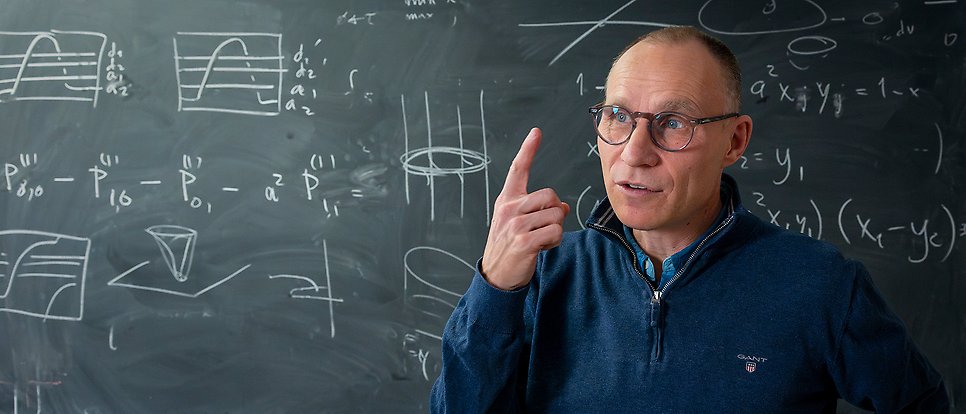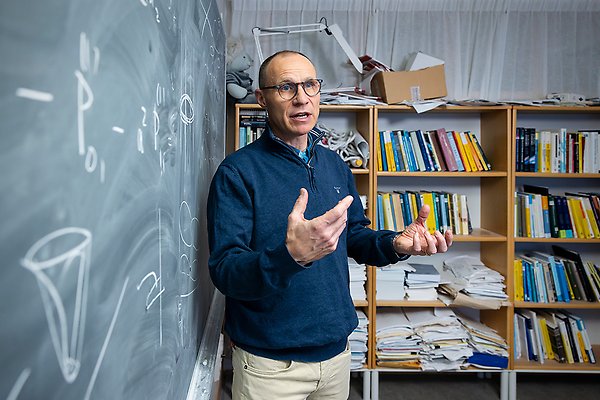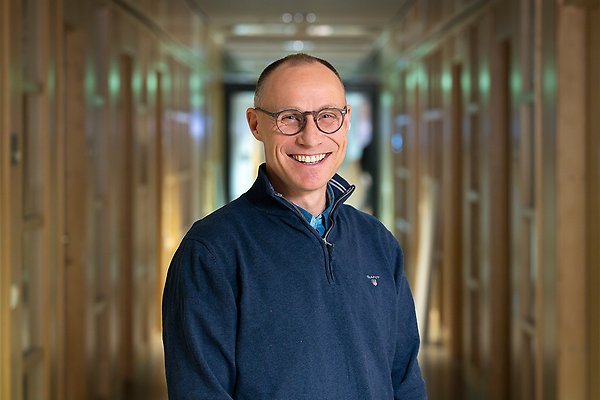Tobias Ekholm sees the power of geometry

Tobias Ekholm is motivated as a researcher by the desire to understand how things work – and his preferred tool is geometry. Photo: Mikael Wallerstedt
In January 2024 a centre of excellence in geometry and physics will open at Uppsala University. One of the people behind the initiative is Tobias Ekholm, Professor of Mathematics, who has long been active at the interface of mathematics and physics.
Tobias Ekholm is motivated as a researcher by the desire to understand how things work – and his preferred tool is geometry. This is a branch of mathematics that borders on physics, which suits him well. When he started out as a student, it was physics rather than mathematics that appealed to him, but that quickly changed.
“I developed a real hunger for mathematics and learned very quickly. I got a great kick out of doing maths properly, in contrast to the way it was done in school.”
As a doctoral student he headed into the research track geometry and topology. His supervisor was the internationally famous Russian mathematician Oleg Viro at Uppsala University. That set the pattern. He went to Stanford and did research there for a few years in the field of symplectic geometry, working with another prominent researcher, Yakov Eliashberg.
“It was a tremendously exciting period, around 1999, when symplectic field theory was first being formulated. It was quite new and I was able to help in a few different ways.”
Similar results
A decisive juncture in his research came around 2010, when he was back in Uppsala. He was engaged in research on mathematical knots and discovered that two researchers in physics had arrived at more or less the same results.
“They were doing something from a physics perspective that exactly matched something we had done in maths. They found a polynomial that matched these mathematical knots and we had found exactly the same polynomial, though in a different way.”
The researchers wondered how these results were related and together, helped by Ekholm’s input, they were able to find a connection. They wrote a joint paper, which proved to be the beginning of research that has now been in progress for more than 10 years.
“I received a Wallenberg Scholar grant that made it possible to employ postdocs in this area, which meant the research could be broadened to include the physics of mathematics.”
Joint pool of researchers
Now there is a joint pool of researchers in mathematics and theoretical physics. They do not work in exactly the same area but have joint seminars, Ekholm explains.
“Some researchers are employed to do research in both maths and physics. This is a bit of a novelty, it hasn’t occurred here previously, though it’s relatively common internationally. It’s the sort of thing that’s grown out of this long period of collaboration and joint seminars.”

The mathematics developed by Ekholm can serve as a support for research in modern quantum physics, which in turn leads to new questions for mathematics. Photo: Mikael Wallerstedt
The new centre of excellence in physics and geometry is a natural extension of this.
“Of course it’s an advantage that we already have people in place and are involved in various international connections in this and closely associated areas. Now we will recruit more postdocs. The research environment is greatly enriched by talented and ambitious people and this is an excellent tool for recruitment.”
Support for research in physics
The mathematics developed by Ekholm can serve as a support for research in modern quantum physics, which in turn leads to new questions for mathematics.
“We have some problems in common and shared techniques that unite us, but we have different approaches from the physics and maths angles,” he explains.
For example, you can build a theoretical structure for understanding experiments conducted at the international research facility CERN.
“To understand a structure, you sometimes need to look at a very stripped-down version of the theory.”

As a researcher in mathematics, Tobias Ekholm spends a great deal of time thinking – but also talking with colleagues, here in Uppsala and in other countries. Photo: Mikael Wallerstedt
As the research is so theoretical, it is difficult to predict potential applications. He makes a comparison with the Greek philosopher Democritus, who worked out how atoms function, nearly 2,500 years ago.
“If anyone had demanded that he provide experimental proof of his theory, it would have been impossible, because this requires various other discoveries, machines and higher energy. It’s similar here, we have to wait.”
Place for exchange of ideas
As a researcher in mathematics, he spends a great deal of time thinking – but also talking with colleagues, here in Uppsala and in other countries. Together they brainstorm around mathematical problems that are currently circulating in the research community.
“It’s the same as for most people, we meet and exchange ideas. Though where theoretical research is concerned, perhaps we spend a little more time thinking individually before we talk with one another.”
He hopes that the new centre of excellence in geometry will be a place for precisely this type of intellectual exchange.
“This grant will enable us to build up a local environment where people can go and chat with other researchers and benefit directly from one another. It’s also important to collaborate with international partners and think about things together,” Ekholm adds.
Annica Hulth
Facts: Tobias Ekholm
Facts: Tobias Ekholm.
Title: Professor of Mathematics.
In the news: Director of a new centre of excellence in geometry and physics that will open in January 2024.
In my spare time: My children are involved in various sports, so I put a lot of time into that.
Latest film seen: Amsterdam.
How I get my best ideas: It’s a matter of thinking about things for a very long time. You wouldn’t imagine it can do any good to go on thinking about the same things for two years without getting anywhere. But actually it does, it’s an amazingly long process.
What makes me happy: It’s great fun when new young people emerge and make important contributions. The research area comes alive when they have room to develop and claim space.
What irritates me: That there are sometimes mechanisms and rules that get in the way.
